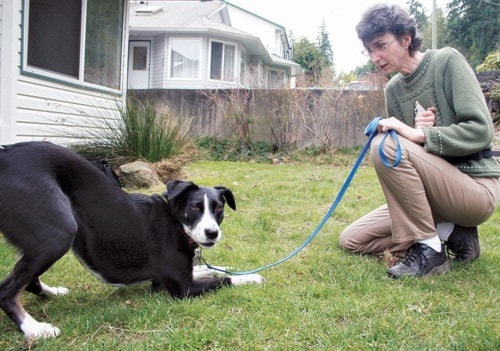Many dog owners talk to their pets, but not everyone knows what the animal is trying to communicate back to them.
Nanaimo’s parks, recreation and culture is offering three classes this month to help people communicate better with their dogs, learn the animal’s verbal communications and body language and what it means.
Instructors Lisa Kerry and Donna Hill share their canine training knowledge with participants.
Kerry owns and operates Dog Gone Good, a dog training service, and is a certified obedience instructor. Hill has a zoology and teaching degree and has worked as a nature interpreter and field biologist for more than 20 years.
Hill’s passion for dogs led her to use her skills to train her own dogs and co-found the Vancouver Island Animal Training Association.
Kerry said dogs have an entire social and communication system of their own and traditional methods of teaching dogs with cues are “terrific”.
However, people also need to understand how to deal with the “dog’s potential fears and anxieties often labelled as dominant behaviour or aggression”.
“Some dogs know a lot of cues and tricks but are socially inept at dealing with settings like agility classes or stimulating settings and environments, said Kerry. “We spent a lot of time developing our program for kids and adults in a way that starts right at the root of the common misunderstandings.”
Talk Dog – Learn to Speak Doggish for ages seven to 11 teaches young people to interpret their dog’s verbal communication and body language and how to play safely with their dog. The six-part course runs Tuesdays from 4-5 p.m. at Beban Social Centre beginning Tuesday (April 17) to May 22.
“One of the things we want to teach the kids is to learn the early warning signs – not just the growl because that’s a real obvious one – but things like the dogs looking away, or the dog is licking his lips or the dog is yawning,” said Hill. “Those are all early cues that the dog is not comfortable and that the child needs to be backing off.”
Hill said the more kids learn to observe and interpret these signs the safer they’ll be.
Participants learn skills through a number of games designed to teach them about emotions and how dogs have similar emotions to humans. In one of the games, participants role play as owners and dogs in a dog park and learn how dogs react in different situations.
Senses of Dogs is also for children ages seven to 11. The Pro-D program is April 23 from 9 a.m. to noon. During a series of games, youth learn about a dog’s sense of sight, smell and hearing and how they compare to their own.
Hill said the focus of the workshop is looking at dogs and seeing how wonderful they are. She said dogs can’t see as much detail as humans but their motion discrimination is much higher.
“Their motion discrimination is much, much greater than ours and that makes sense given their background as hunters and scavengers,” she said. “They have to see movement and say is that something I can eat, is that something to chase.”
Communication and the Modern Dog is a workshop for adults April 30 from 6-9 p.m. at Beban Park Social Centre.
It teaches participants about subtle cues dogs give – how to read them – and what actions to take. People learn how to read the signals indicating their dog isn’t comfortable in a situation to avoid altercations.
For more information on the classes or to register, please call 250-756-5200 or go to www.nanaimo.ca.
